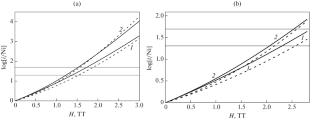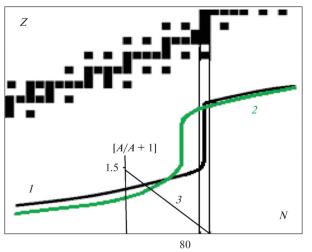r过程中的磁化原子核
IF 0.48
Q4 Physics and Astronomy
Bulletin of the Russian Academy of Sciences: Physics
Pub Date : 2025-08-18
DOI:10.1134/S1062873825711973
引用次数: 0
摘要
研究了超磁重原子核的合成。这种核是在II型超新星爆炸和中子星合并中形成的。在0.1-10 TT的磁场中,塞曼效应导致线性的核磁响应,可以用磁化率来描述。在磁场的影响下,r过程的路径随着质量小于magic的原子核比例的增加而变化,r过程峰处质量较小的核素的体积也随之增加。本文章由计算机程序翻译,如有差异,请以英文原文为准。


Magnetized Nuclei in the r-Process
The synthesis of ultramagnetized heavy atomic nuclei is considered. Such nuclei are formed during type II supernova explosions and neutron star mergers. In a magnetic field of 0.1–10 TT, the Zeeman effect leads to a linear nuclear magnetic response, which can be described in terms of magnetic susceptibility. Under the influence of magnetic fields, the path of the r-process changes with an increase in the fraction of nuclei with masses less than magic, as well as the volume of nuclides of smaller masses at the r-process peaks increases.
求助全文
通过发布文献求助,成功后即可免费获取论文全文。
去求助
来源期刊

Bulletin of the Russian Academy of Sciences: Physics
Physics and Astronomy-Physics and Astronomy (all)
CiteScore
0.90
自引率
0.00%
发文量
251
期刊介绍:
Bulletin of the Russian Academy of Sciences: Physics is an international peer reviewed journal published with the participation of the Russian Academy of Sciences. It presents full-text articles (regular, letters to the editor, reviews) with the most recent results in miscellaneous fields of physics and astronomy: nuclear physics, cosmic rays, condensed matter physics, plasma physics, optics and photonics, nanotechnologies, solar and astrophysics, physical applications in material sciences, life sciences, etc. Bulletin of the Russian Academy of Sciences: Physics focuses on the most relevant multidisciplinary topics in natural sciences, both fundamental and applied. Manuscripts can be submitted in Russian and English languages and are subject to peer review. Accepted articles are usually combined in thematic issues on certain topics according to the journal editorial policy. Authors featured in the journal represent renowned scientific laboratories and institutes from different countries, including large international collaborations. There are globally recognized researchers among the authors: Nobel laureates and recipients of other awards, and members of national academies of sciences and international scientific societies.
 求助内容:
求助内容: 应助结果提醒方式:
应助结果提醒方式:


